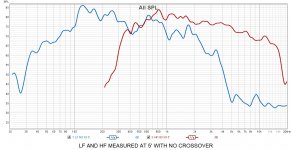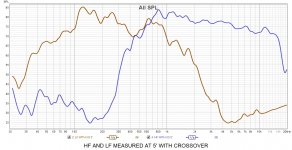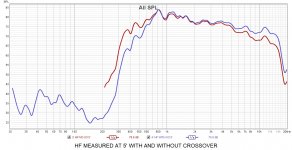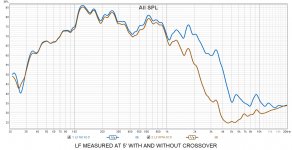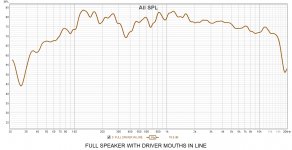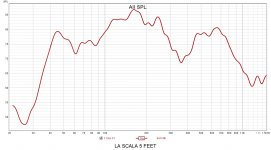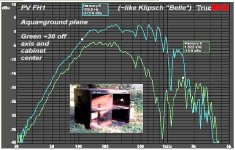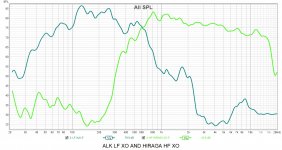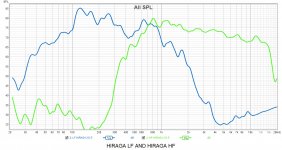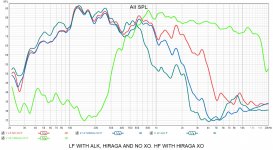I did find published impedance plots of the woofer and the R-H driver. Yours will be different because of the different horns, but it's a start.
The crossover you drew does not seem well adapted to your divers at all, but with your close measurements it can be hard to tell. Is it possible for you to do sweeps with the mic at 1M or 5 feet? No crossovers. That would help us know a little better what's going on.
Here are the measurements requested. All measurements were done at 5 feet, and descriptions are included under each measurements. I used 1/6th smoothing. Thanks for suggesting the capture function. It is very convenient.
Attachments
Last edited:
Thanks, I'll see what I can figure out from these. The woofer is looking gnarly and isn't going to be easy. What do you think is causing such an uneven response?
Is it possible that I didn’t install the woofer properly, and that it iallowing air to leak around it? The back chamber is supposed to be sealed. Would a leak cause the sort of aberrations in response that you see in the sweeps?
I don't know. Is your bass cabinet the Peavy? The woofer hump shows up in your measurements as far back as July.
I’ll check my old measurements but, from memory, I started using REW after installing the Eminence 15C into the Peavey cabs.
I don't know. Is your bass cabinet the Peavy? The woofer hump shows up in your measurements as far back as July.
Yes, it is a Peavey FH-1 bass bin.
Just for reference, this is a REW sweep of my La Scala bass bin from 5 feet away. The Peavey bass bin is very similar to a La Scala bass bin and shares much of its good qualities, but also it’s bad qualities. This La Scala is stock except for a capacitor refresh. If the hump you are referring to is the one at about 140 HZ, that is fairly typical of La Scala and similar bass bins.
Attachments
No. It has the stock Klipsch K-33 woofer in it. My understanding is that the hump around 140 HZ is a product of the short horn design of the La Scala bass bin that is also the case with the FH-1 and the Belle Klipsch. Changing the woofer to Crites, K-43 or 15C from the K-33 changes how low or high that each woofer plays in these bins but, from what I recall, the hump remains regardless of woofer.
Hmm, according to this, the K-33-E is an Eminence Kappa 15C, so ought to measure the same 😉: K-33-E Frequency Response Chart - 2-Channel Home Audio - The Klipsch Audio Community
GM: The Eminence Kappa 15C is supposed to be more like a K-43 than a K-33. Folks on the Klipsch Forum say that like the the K-43, the 15C is better at the top of its range at the expense of the bottom where it gives up a few HZ of extension. The hump is there with all of these woofers though. Happy New Year!
This is a tough nut to crack. With a roller coaster woofer response like that, I'm at a loss as to where to start. With digital crossover EQ that response could be flattened, but why is it starting out that bad? Much thinking to do.
Are the measurements done outside or in room ? My horns measure very different indoors to out...
I'm following this thread closely as I planned to build an FH1 for a test listen. (Am running 80Hz straight horns at the moment)
Rob.
I'm following this thread closely as I planned to build an FH1 for a test listen. (Am running 80Hz straight horns at the moment)
Rob.
Rob: The measurements are all done indoors in a room that is 24’ X 16’ X 7’. The response measurements that I am getting seem to track others posted online for short horns similar to the La Scala, and are also in line with the La Scala bass bin measurement that I posted above.
This is a tough nut to crack. With a roller coaster woofer response like that, I'm at a loss as to where to start. With digital crossover EQ that response could be flattened, but why is it starting out that bad? Much thinking to do.
Pano: While the ragged response measurements may appear to be a problem, in operation they don't really sound like one. Perhaps I'm accustomed to the sonic signature of this sort of bass horn. I think that getting the low pass portion of the crossover to overlap less with the high pass portion would help it to sound better. I have been looking at a couple of higher order low pass sections of crossovers that might be appropriate, including a 600 HZ one designed by ALK that is for La Scala type short horns like the FH1. This crossover is described as an "extreme slope" crossover, and I have the parts for it on hand. A description and a schematic can be found here...
New extreme-slope crossover requiring NO Zobel - Technical/Modifications - The Klipsch Audio Community
Thanks Tizman,
The reason I asked is that often measuring in room includes lots of extra dips / peaks that are not there when measured outside. (floor bounce / wall reflections) I find it easier working with outdoor measurements.
Cheers,
Rob.
The reason I asked is that often measuring in room includes lots of extra dips / peaks that are not there when measured outside. (floor bounce / wall reflections) I find it easier working with outdoor measurements.
Cheers,
Rob.
I looked around the 'Net and there are a surprising number of measurements if this cabinet out there. The all have the hump and not much low end. I guess the horn was designed to have very high output in the mid bass for kick drum thump.
I did not see any measurements with the big dip circa 425 Hz.
I did not see any measurements with the big dip circa 425 Hz.
I looked around the 'Net and there are a surprising number of measurements if this cabinet out there. The all have the hump and not much low end. I guess the horn was designed to have very high output in the mid bass for kick drum thump.
I did not see any measurements with the big dip circa 425 Hz.
I did another indoor measurement with the mic very close to the floor and 5’ from the bass bin, and the dip at around 425 HZ is reduced in that measurement. I’ll post it and a couple more shortly. Maybe this is why Mr. Klipsch chose 400 HZ as the crossover for La Scala? The “sort of” ground plane measurement is a bit better.
Last edited:
Here are two captures comparing the Hiraga LF and ALK LF portions of the XO with the Hiraga HF XO portion. Also attached is a capture of the LF with Hiraga, ALK and no XO along with the HF with the Hiraga filter. It looks like the ALK LF filter will sum better than the Hiraga LF filter with the Hiraga HF section.
From these captures, and confirmation online of the dip at 400-425 HZ, it seems obvious why 400 HZ would have been the crossover point chosen by Mr. Klipsch for a La Scala bin. That said, a two way, rather than the three way of a La Scala, requires a higher crossover point in order to accomodate the compression drivers I have at hand.
Also, would a bit more shaping help on the HF? Reducing the the response from 800-3000 HZ a few DB would flatten the HF response.
From these captures, and confirmation online of the dip at 400-425 HZ, it seems obvious why 400 HZ would have been the crossover point chosen by Mr. Klipsch for a La Scala bin. That said, a two way, rather than the three way of a La Scala, requires a higher crossover point in order to accomodate the compression drivers I have at hand.
Also, would a bit more shaping help on the HF? Reducing the the response from 800-3000 HZ a few DB would flatten the HF response.
Attachments
Last edited:
- Home
- Loudspeakers
- Multi-Way
- Jean Hiraga Altec A5 Crossover modification
